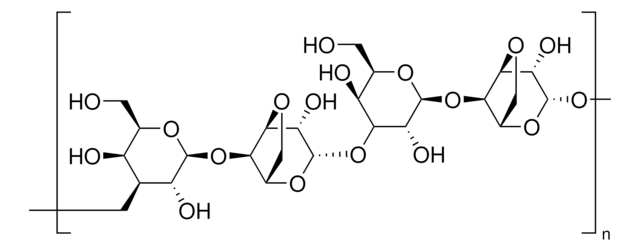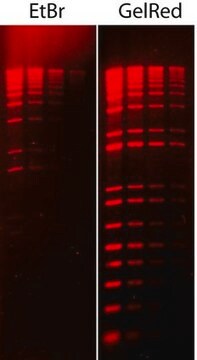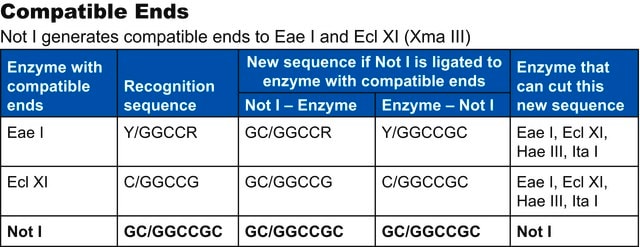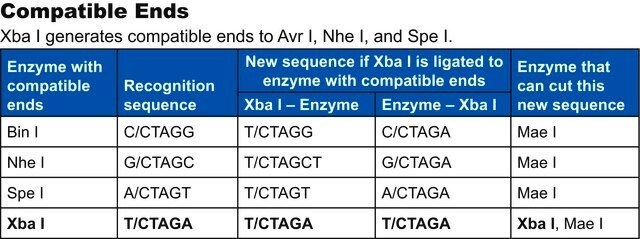R6265
EcoR I from Escherichia coli BS5
Restriction Enzyme
Sign Into View Organizational & Contract Pricing
All Photos(1)
About This Item
CAS Number:
EC Number:
MDL number:
UNSPSC Code:
12352204
NACRES:
NA.53
Recommended Products
grade
Molecular Biology
for molecular biology
form
buffered aqueous glycerol solution
concentration
10,000 units/mL
shipped in
wet ice
storage temp.
−20°C
Looking for similar products? Visit Product Comparison Guide
Specificity
Recognition sequence: 5′-G/AATTC-3′
Cutting results: a 2-10-fold EcoR I overdigestion of 1 μg λ DNA substrate results in 100% cutting
Heat inactivation: 65 °C for 20 minutes.
Cutting results: a 2-10-fold EcoR I overdigestion of 1 μg λ DNA substrate results in 100% cutting
Heat inactivation: 65 °C for 20 minutes.
Application
EcoRI is a restriction endonuclease that is used in molecular biology applications to cleave DNA at the recognition site 5′-G/AATTC-3′, generating fragments with 5′-cohesive termini.
Other Notes
Supplied with 10x Restriction Enzyme Buffer SH (B3657).
Comment: Avoid suboptimal reaction conditions such as low salt, high pH (>8.0) and high glycerol (>5%) as they will alter EcoRI specificity and precipitate star activity.
Unit Definition
One unit is the enzyme activity that completely cleaves 1 mg of λDNA in 1 hour at 37 °C in a total volume of 50 ml of 1x digestion buffer SH for restriction enzymes. 1 mg pBR322 DNA is digested completely by 2 units of EcoR I.
Physical form
Solution in 10 mM Tris-HCl, pH 7.2 , 1 mM EDTA, 200 mM NaCl , 0.5 mM dithioerythritol, 50% glycerol (v/v), 0.2% Triton X- 100 (v/v), 4°C
related product
Signal Word
Danger
Hazard Statements
Precautionary Statements
Hazard Classifications
Resp. Sens. 1
Storage Class Code
11 - Combustible Solids
WGK
WGK 3
Flash Point(F)
Not applicable
Flash Point(C)
Not applicable
Personal Protective Equipment
dust mask type N95 (US), Eyeshields, Gloves
Choose from one of the most recent versions:
Already Own This Product?
Find documentation for the products that you have recently purchased in the Document Library.
J Hedgpeth et al.
Proceedings of the National Academy of Sciences of the United States of America, 69(11), 3448-3452 (1972-11-01)
The sequence of DNA base pairs adjacent to the phosphodiester bonds cleaved by the RI restriction endonuclease in unmodified DNA from coliphage lambda has been determined. The 5'-terminal nucleotide labeled with (32)P and oligonucleotides up to the heptamer were analyzed
C Kessler et al.
Gene, 92(1-2), 1-248 (1990-08-16)
The properties and sources of all known class-I, class-II and class-III restriction endonucleases (ENases) and DNA modification methyltransferases (MTases) are listed and newly subclassified according to their sequence specificity. In addition, the enzymes are distinguished in a novel manner according
Cong Zhu et al.
Nucleic acids research, 41(4), 2455-2465 (2013-01-11)
Zinc-finger nucleases (ZFNs) have been used for genome engineering in a wide variety of organisms; however, it remains challenging to design effective ZFNs for many genomic sequences using publicly available zinc-finger modules. This limitation is in part because of potential
Annabel A Ferguson et al.
Methods in molecular biology (Clifton, N.J.), 940, 87-102 (2012-10-30)
The generation of transgenic animals is an essential part of research in Caenorhabditis elegans. One technique for the generation of these animals is biolistic bombardment involving the use of DNA-coated microparticles. To facilitate the identification of transgenic animals within a
TALENs and ZFNs are associated with different mutation signatures.
Yongsub Kim et al.
Nature methods, 10(3), 185-185 (2013-02-12)
Our team of scientists has experience in all areas of research including Life Science, Material Science, Chemical Synthesis, Chromatography, Analytical and many others.
Contact Technical Service









